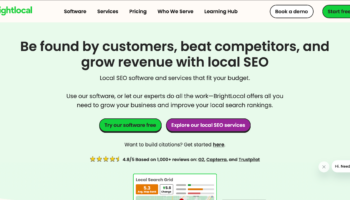Artificial intelligence (AI) is reshaping how search engines operate, and Google’s AI Overviews (AIOs) mark a significant shift. These AI-generated summaries, appearing directly in search results, impact rankings, website traffic, and content strategies. Understanding AIOs is now essential for digital marketers, content creators, and businesses aiming to stay competitive.
This article explores the prevalence of AI Overviews, what triggers them, their impact on SEO traffic, user behavior, and actionable strategies to optimize content for this evolving search landscape.
The Prevalence of AI Overviews: A Shifting Landscape
AI Overviews don’t appear for every query, but their presence is growing. Initial studies showed AIOs in 12.5%–42% of searches. More recent data suggests stabilization or even a slight decline, with occurrences in 4.5%–6.7% of queries.
However, their impact varies by industry. Some sectors, particularly those reliant on informational content, experience a higher frequency of AIOs.
Industry-Specific Distribution of AI Overviews
The prevalence of AI Overviews is industry-dependent:
– Health & Wellness: 55%–67% of relevant keywords trigger AIOs.
– Technology: 23%–36% of keywords display AIOs.
– Finance & Business: 17%–23% of searches show AIOs.
– Shopping & E-commerce: AIOs appear in 40%+ of searches, impacting organic CTRs.
– Travel & Tourism: Common for queries like “best time to visit Bali” or “things to see in Rome.”
– Education: AIOs summarize complex topics, influencing student research.
Recognizing these industry trends allows businesses to refine their SEO strategies accordingly.
Decoding the Triggers: What Makes AI Overviews Appear?
AI Overviews are not random; they are triggered by specific factors:
– Search Intent: Over 80% of AIOs are triggered by informational queries containing words like “how,” “what,” and “why”.
– Query Length: Long-tail queries (five or more words) are more likely to trigger AIOs.
– SERP Features: AIOs and Featured Snippets appear together in 50%+ of cases.
– Absence of PPC Ads: Google avoids AIOs on highly commercial queries where ads dominate.
– Content Format: Queries with structured answers—lists (ordered/unordered/nested), tables, and step-by-step guides—are favored.
The Impact on SEO: Traffic, CTR, and Visibility
AI Overviews significantly impact SEO performance, shifting traffic and click behaviors.
Organic Search Visibility: A Downward Shift
AIOs push organic results down, reducing visibility:
- Organic search results move down 200–900 pixels when AIOs appear.
- On mobile, AIOs can occupy 50% of the screen above the fold, making organic results less visible.
Click-Through Rate (CTR) Reductions
AIOs can lead to an 8.9% drop in organic CTRs (**Semrush, 2024**). Pages appearing below AIOs see a **20%–30% decrease in click volume** compared to similar queries without AIOs.
User Behavior and Experience
While AIOs provide quick answers, studies show mixed user reception:
- Google reports a 25% increase in user satisfaction for queries answered via AIOs.
- SEO industry concerns highlight the risk of lower organic engagement and reduced publisher visibility.
The Citation Boost: A Silver Lining
Being cited in AIOs provides a small but notable traffic boost:
- Cited websites see CTR improvements from 0.74% to 1.02%.
- Surfer SEO research found that well-structured data increases citation probability by 37%.
Strategies for Getting Cited in AI Overviews
Optimizing for AIOs requires a new approach, focusing on citation potential over keyword rankings.
1. Content Relevance & Quality
AI favors content closely matching the AI-generated response.
– Use structured responses, schema markup, and conversational yet authoritative tone.
2. SERP Position: Important, But Not the Only Factor
- 40%+ of AIO citations come from outside the top 10 rankings.
- 75% of cited pages rank in the top 12, but top 3 rankings don’t guarantee citation.
3. Optimize for Featured Snippets
- 60%+ of AIO citations also appear in Featured Snippets.
- Use tables, bullet points, and clear H2/H3 subheadings to increase chances.
4. AI-Friendly Formatting
- Lists: Ordered (e.g., step-by-step guides), unordered (e.g., key points), and nested lists improve readability.
- Tables: Structured comparison tables increase citation chances.
- Schema Markup: Implement FAQ, How-To, and Article schema for better AI recognition.
- Examples: Below is a well-optimized content snippet that has a high likelihood of being cited:
<h2>How to Improve SEO for AI Overviews</h2>
<p>To increase the chances of citation in AI Overviews, follow these key steps:</p>
<ol>
<li>Use structured data markup (Schema.org FAQ or HowTo).</li>
<li>Provide concise, fact-based answers.</li>
<li>Format content using lists, tables, and bullet points.</li>
</ol>
5. Diversify Content Distribution
- YouTube and Wikipedia are the most frequently cited sources in AIOs.
- LinkedIn, Reddit, and Google’s Knowledge Graph citations are increasing.
Future of AI Overviews in SEO
AIOs are evolving, with potential expansion into e-commerce, local search, and transactional queries. Key trends to monitor:
- Challenges for Google: Ensuring accuracy, reducing bias, and handling misinformation.
- Citation Frequency Changes: Will Google increase or limit citations?
- AI Model Improvements: More refined, accurate answers.
- Ethical Considerations: How will AIOs balance publisher rights and information accessibility?
- Industry Implications: Retail, legal, and financial industries may require **new AI SEO frameworks** to maintain traffic.
Adapting Your SEO Strategy for AI Overviews
To stay ahead in the evolving search landscape:
- Monitor Search Queries: Identify where AIOs appear and their impact.
- Focus on Long-Tail Queries: Optimize for specific, detailed searches.
- Structure Content for AI & Featured Snippets: Use lists, tables, and schema markup.
- Enhance Brand Authority: Build credibility in your niche.
- Expand Beyond Traditional SEO: Leverage YouTube, LinkedIn, and Reddit to gain AI citations.
PS: Image is taken from LinkedIn.






